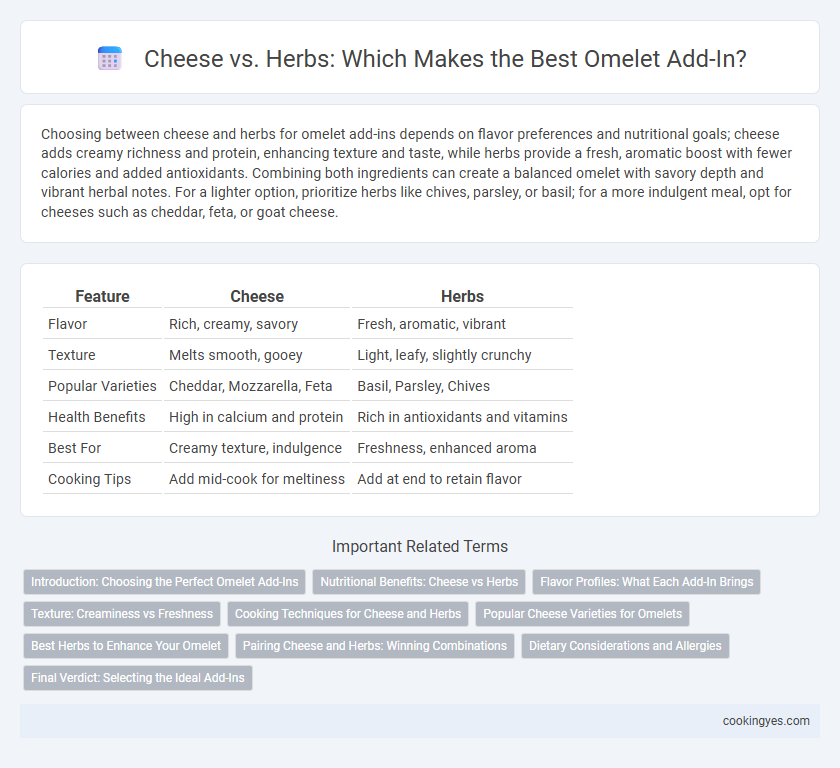Choosing between cheese and herbs for omelet add-ins depends on flavor preferences and nutritional goals; cheese adds creamy richness and protein, enhancing texture and taste, while herbs provide a fresh, aromatic boost with fewer calories and added antioxidants. Combining both ingredients can create a balanced omelet with savory depth and vibrant herbal notes. For a lighter option, prioritize herbs like chives, parsley, or basil; for a more indulgent meal, opt for cheeses such as cheddar, feta, or goat cheese.
Table of Comparison
| Feature | Cheese | Herbs |
|---|---|---|
| Flavor | Rich, creamy, savory | Fresh, aromatic, vibrant |
| Texture | Melts smooth, gooey | Light, leafy, slightly crunchy |
| Popular Varieties | Cheddar, Mozzarella, Feta | Basil, Parsley, Chives |
| Health Benefits | High in calcium and protein | Rich in antioxidants and vitamins |
| Best For | Creamy texture, indulgence | Freshness, enhanced aroma |
| Cooking Tips | Add mid-cook for meltiness | Add at end to retain flavor |
Introduction: Choosing the Perfect Omelet Add-Ins
Cheese and herbs each bring distinctive flavors and textures to an omelet, enhancing its taste profile in unique ways. Cheese adds creamy richness and a savory depth, with popular choices like cheddar, feta, or goat cheese melting smoothly into the eggs. Fresh herbs such as chives, parsley, or basil introduce vibrant, aromatic notes that brighten the dish and complement the eggs' natural flavor.
Nutritional Benefits: Cheese vs Herbs
Cheese adds a rich source of protein, calcium, and vitamin B12 to omelets, supporting bone health and muscle function. Herbs contribute antioxidants, vitamins A, C, and K, and anti-inflammatory properties, enhancing immunity and digestion. Combining both cheese and herbs maximizes nutritional benefits by blending essential minerals with natural phytonutrients.
Flavor Profiles: What Each Add-In Brings
Cheese adds a rich, creamy texture and savory depth to an omelet, with varieties like cheddar delivering sharpness, mozzarella offering mildness, and blue cheese imparting pungent tanginess. Herbs such as chives, parsley, and tarragon contribute fresh, aromatic notes that brighten the overall flavor, enhancing the egg's natural taste with subtle earthiness or slight peppery accents. Combining cheese with herbs creates a harmonious balance of creamy richness and vibrant freshness, elevating the omelet's complexity and appeal.
Texture: Creaminess vs Freshness
Cheese in an omelet provides a rich, creamy texture that melts smoothly, enhancing the overall mouthfeel with a luscious, velvety consistency. Herbs contribute a fresh, light texture that adds subtle crispness and a natural, aromatic bite without weighing down the omelet. Combining cheese and herbs balances creaminess with brightness, creating a more complex and enjoyable texture profile.
Cooking Techniques for Cheese and Herbs
Cheese melts smoothly in an omelet when added while the eggs are partially set, creating a rich and creamy texture that enhances flavor. Fresh herbs, such as chives or parsley, are best folded in at the end of cooking to preserve their vibrant taste and aroma. Using low heat ensures cheese melts evenly without burning, while herbs retain their freshness and nutritional value.
Popular Cheese Varieties for Omelets
Popular cheese varieties for omelets include cheddar, mozzarella, Swiss, and feta, each offering distinct flavors and textures that enhance the dish. Cheddar provides a sharp, creamy taste, while mozzarella melts smoothly for a gooey consistency; Swiss adds a nutty flavor, and feta contributes a tangy, crumbly element. Choosing the right cheese depends on the desired flavor profile, with herbs like chives, parsley, or basil often paired to complement and elevate the overall taste experience.
Best Herbs to Enhance Your Omelet
Fresh herbs like chives, parsley, and tarragon add bright, aromatic flavors that elevate the creamy texture of an omelet without overpowering it. Basil and thyme provide subtle earthiness and complexity, enhancing the overall taste while complementing cheese varieties such as cheddar or feta. Incorporating herbs into your omelet boosts nutritional value with antioxidants and vitamins, creating a balanced and flavorful meal.
Pairing Cheese and Herbs: Winning Combinations
Pairing sharp cheddar with fresh chives enhances an omelet's flavor by balancing creamy texture and vibrant herbal notes. Combining feta cheese with dill introduces a tangy, Mediterranean-inspired taste that brightens the dish. Goat cheese and basil create a rich yet aromatic profile, perfect for a gourmet omelet experience.
Dietary Considerations and Allergies
Cheese adds rich flavor and protein to an omelet but may pose challenges for those with lactose intolerance or dairy allergies, requiring lactose-free or plant-based alternatives. Herbs such as chives, parsley, or basil provide low-calorie, allergen-friendly flavor enhancements rich in antioxidants and vitamins, suitable for most dietary restrictions. Selecting add-ins should consider individual dietary needs, allergy risks, and nutritional goals to ensure a safe and enjoyable omelet experience.
Final Verdict: Selecting the Ideal Add-Ins
Cheese and herbs each bring unique qualities to an omelet, with cheese offering a rich, creamy texture and herbs contributing vibrant, fresh flavors. Selecting the ideal add-ins depends on desired taste profiles: cheese varieties like cheddar, feta, or mozzarella enhance indulgence, while herbs such as chives, parsley, or dill provide aromatic brightness. Balancing both creates a harmonious omelet that satisfies both savory depth and refreshing herbal notes.
Cheese vs Herbs for omelet add-ins Infographic

 cookingyes.com
cookingyes.com